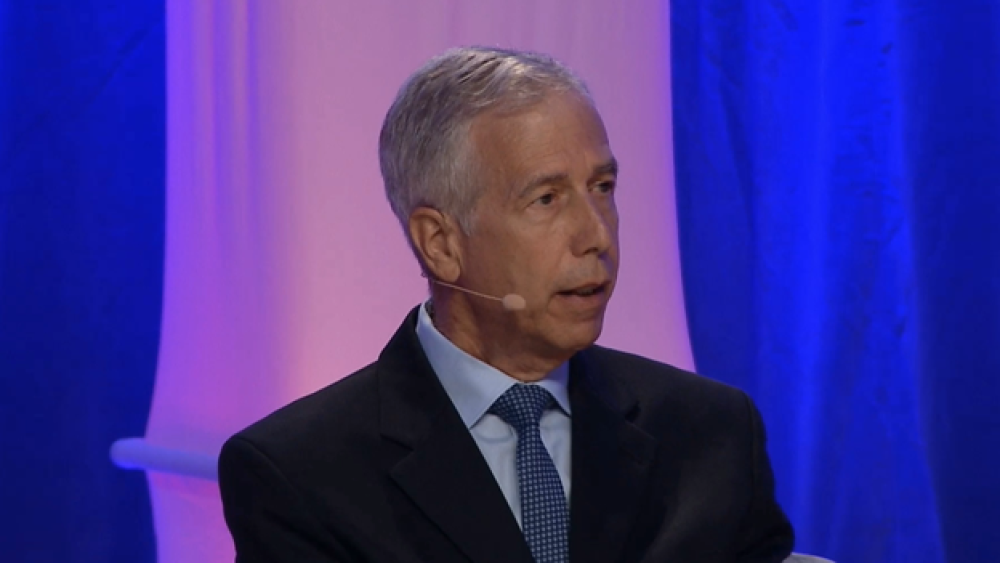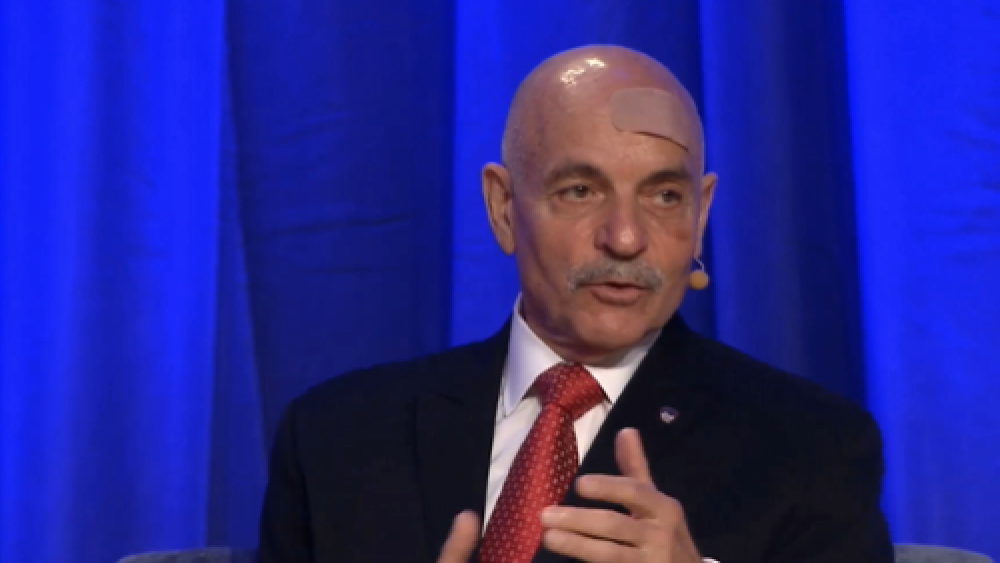“We knew this was going to be the worst day of our lives.”
FDNY Commissioner (ret.) Sal Cassano described the initial moments of September 11, 2001. Cassano was serving as an Operations officer at the time but would later, in the aftermath of the tragedy, go on to help redesign and rebuild the department after losing 343 members.
Cassano, along with other leaders who were instrumental in leadership and operational roles during the terrorist attacks, shared reflections on 9/11 as part of a 20-year anniversary memorial tribute and panel discussion at the IAFC’s flagship conference, Fire-Rescue International 2021, happening this week in Charlotte, N.C.
Like Cassano, the other leaders who addressed the industry-shaking event are members of the IAFC’s Terrorism and Homeland Security Committee:
- Chief Joe Pfeifer: Senior Fellow, Program on Crisis Leadership, Harvard Kennedy School; Director of Crisis Leadership, Columbia University; Chief of Counterterrorism and Emergency Preparedness for FDNY.
- Jim Schwartz: Deputy County Manager, Arlington County, Virginia; Former Fire Chief, Arlington County, Va.
- Chris Combs: National Security Executive and Special Agent in Charge, FBI.
This was the first time these four men have spoken together about their 9/11 experiences and how public safety agencies have built and improved preparedness after the attacks.
Play by play: “The fog of war”
Chief Pfeifer was the first chief on scene at the World Trade Center attack. He recalls working a call for a smell of gas, when he heard the loud roar of jet engines – a rarity in Manhattan – and looked up to see the first plane slam into the North Tower.
“There were hundreds of thoughts going through my mind,” he said. “I had to slow my thinking down a bit. The plane was aiming for the building.”
Pfeifer recalled the conversations with fellow firefighters being directed to advance up the stairwell: “Every first responder made a personal decision to go in. They knew they were going to the most dangerous jobs of their lives. … They did some ordinary things [in the process]. They told people [coming down the stairwells] ‘don’t stop. You can make it out of here.’”
At the Pentagon, the Arlington County Fire Department was the lead agency for the response, and Chief Schwartz led the unified command effort.
“People talk about the ‘fog of war,’” Schwartz said. “That’s absolutely what we were dealing with. There’s a lot going on to process.” He noted that he had the benefit of seeing the images coming out of New York, making it clear this was a terrorist attack.
FBI Special Agent Chris Combs arrived at the Pentagon shortly after Schwartz. “This was not just an attack, it was an act of war,” he said, adding that he was immediately thinking about how to communicate key intel to Schwartz.
One saving grace: “We had been training for years for an event like this,” Combs said. In fact, there had been a full-scale multi-agency exercise in Fairfax, Va., the Saturday before 9/11 so they had all just been together for training. “We knew how to do this. We knew how to operate,” he noted.
Teams at the Pentagon eventually received a message that another airplane was headed toward D.C. and would arrive in 17 minutes. The immediate assumption was that the Pentagon would again be the target. Combs said having the relationships already established between agencies meant everyone was on the same page about what to do next – evacuate the area.
Schwartz explained that the Command Post was moved to a position under Interstate 395, adding that even when the second plane never materialized, Combs made the smart decision to assert that the Command Post stay in its new location.
Back in New York, when the South Tower was hit, Cassano recalled thinking it was a secondary explosion from the original hit on the North Tower. After realizing it was the other tower, he thought, “We’re going to need a lot more chaplains here.”
Towers fall: “Pitch black”
At 9:59 a.m., 102 minutes after the North Tower was struck, the South Tower began to collapse, creating another roaring sound. Pfeifer recalled thinking something may have fallen off the plane or perhaps the elevators were blowing out, but then, the entire lobby went black. “I couldn’t see the hand in front of my face,” he said. “I had no idea a skyscraper had just collapsed.”
In a devastating moment, Pfeifer felt something at his feet and realized it was FDNY Chaplain Mychal Judge: “Father Judge [had been] in the lobby of the North Tower with me. I saw our chaplain praying, asking God for this event to pass. When I bent down, I removed his white collar and checked his pulse. Our beloved chaplain was gone.”
Cassano, who was now with FDNY Chief Peter Ganci, also recalled the terrifying moments of the collapse: “We escaped into the garage. Pitch black, can’t see, can’t breathe.”
He said they held their ground there until the massive dust cloud cleared a bit. They then made their way back to where the Command Post had been – but it was gone. Ganci decided to head off to help with rescue efforts. “He was going to lead by example, knowing this was the worst day of our lives,” Cassano said.
Chief Ganci was killed in the collapse of the North Tower.
Post-9/11 reflections: “We’ve broken down those barriers”
September 11 was an industry-altering event that forever changed the fire service – and the world. Naturally, many aspects of command and control, communications, safety and training would come under scrutiny for years to come, but also lead to the development of new systems and programs to improve disaster response efforts.
Pfeifer focused on a critical system to emerge in the aftermath of 9/11 – the National Incident Management System (NIMS) – highlighting the exemplary work of Schwartz and Combs in its development.
Schwartz explained that the area of emergency management has been prioritized following 9/11. Previously it was normally a program within a fire or police department, but now, “Recognition that it has to be an equal agency has become more the norm.”
Further, Schwartz explained how empathy is a key part of building relationships with other agencies: “If we acknowledge that our success is dependent on our relationships with others … it’s important to be able to look at a particular problem through the eyes of others.” For example, a firefighter and police officer looking at the Pentagon attack will process the same scene in a different way. “We must remember that our view isn’t the only one.”
Combs highlighted that 9/11 forced the federal government to work closely with local and state partners. He also lauded the work that’s been accomplished to better connect agencies at all levels: “Whatever’s going to happen tomorrow, by being on that common system and training together, I’m not worried about it, because we’ve broken down those barriers. We’re going to show up and get it done. We’re going to get through it.”
Looking to the future: “Break bread together”
Although we are 20 years post-9/11, and disaster preparedness has evolved, there is more work to be done and always lessons to be learned, the leaders explained.
Schwartz focused on the need for agencies to be adaptable in moments of crisis, particularly with new and evolving threats. He also noted the need for organizations to develop the best people to fill the right positions.
Cassano reiterated that chiefs must be prepared for terrorist attacks: “It can happen in any city, in any place, at any time,” adding that while it may not be on the same scale as 9/11, it could certainly be an active shooter incident or natural disaster. This is why, he said, it’s vital to have great staff who are properly trained.
Combs pointed out that although we are 20 years post-9/11, some of the same issues still come up in after-action reviews, meaning there is still work to be done to integrate response efforts among agencies.
Pfeifer suggested that a critical way to accomplish this is by breaking bread together – a key to building trust among agencies.
A final message: “So others may live”
Pfeifer concluded the panel discussion with a story about visiting One World Trade Center shortly after it opened in 2014. As part of a tour with the Port Authority, he was directed to the very top of the building – the tallest in the United States – as high as they could go, climbing metal exterior stairs to a point just below the antenna.
On the way up, Pfeifer thought about terrorism and how 9/11 was not just an attack on NYC – it was attack on all of humanity. “As you look at the four of us, we can say that we are a victim of terrorism, and all of you [are as well],” he said.
Once at the top, overlooking New York and New Jersey, the view took his breath away.
The Port Authority representative asked him if he could write something on the steel for generations to come. He immediately thought of the two questions people ask him most. The first question – “What is a hero?” – is relatively simple to answer: Someone who does ordinary things at an extraordinary time. The second question, however, is much harder to process and one no chief wants to hear: “Why did my loved one have to run into the burning towers?” Pfeifer said it took him much longer to contemplate the right answer, but he eventually found it: We run into danger so others may live.
And with that, Chief Pfeifer wrote at the top of One World Trade Center, “Always remember the heroes who did ordinary things at extraordinary times so others may live.”



















